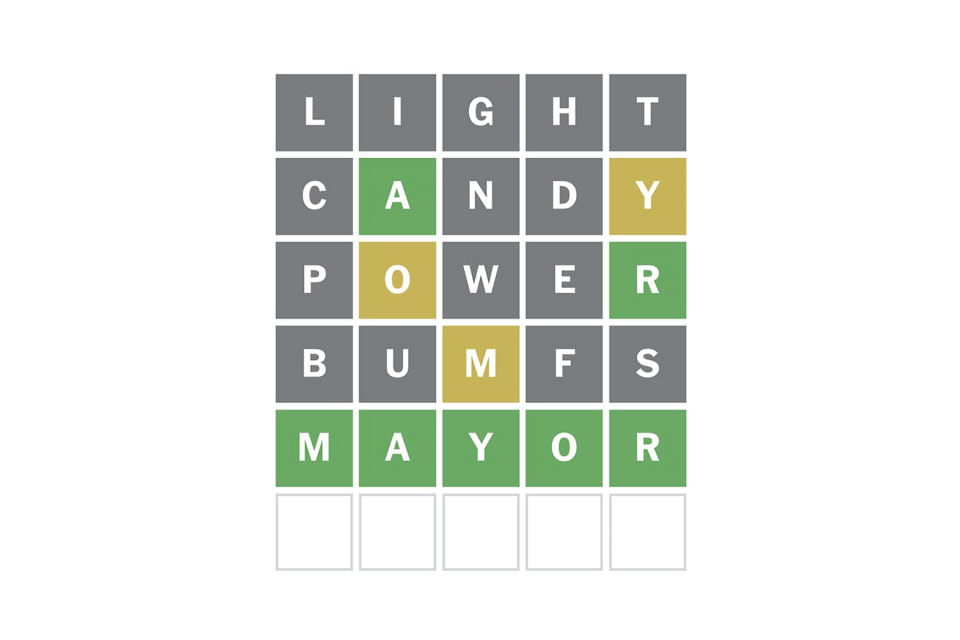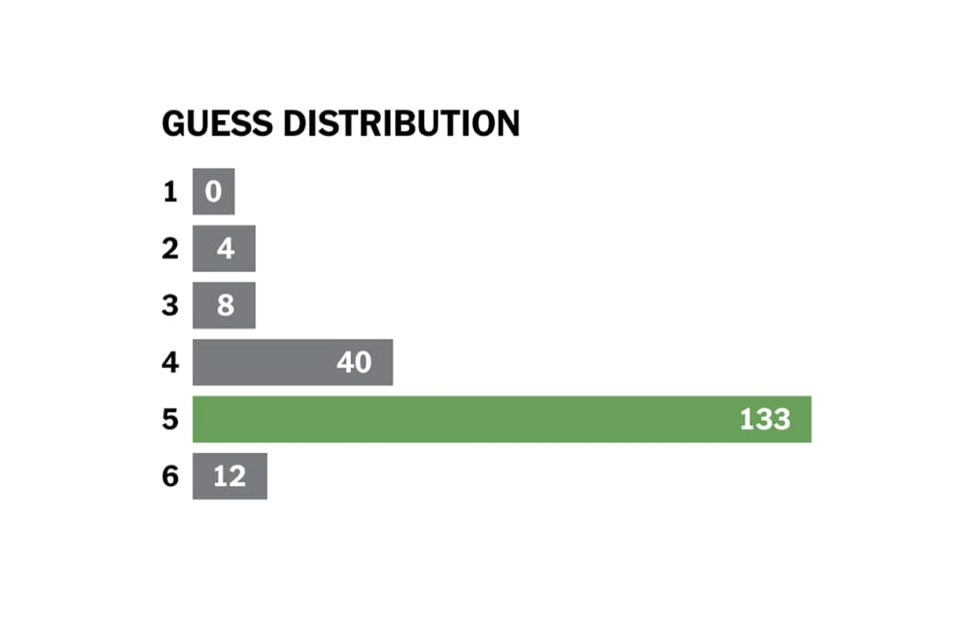The Fastest Wordle Winning Strategy Ever
Want a rapid-fire way to win Wordle in 30 seconds or less, every single time?
It sounds implausible, but it’s ridiculously simple. My friend Dove Sussman, a screenwriter living in Puerto Escondido, Mexico, came up with the method and does it every day. He taught the technique to his 10- and 11-year-old sons, Dexter and Darius, and the three of them taught me.
Here’s what to do: Guess LIGHT, CANDY, POWER, and BUMFS. That’s four guesses with 20 unique letters, including all five vowels. At that point—after only a few seconds of typing—you’re pretty much guaranteed to know all the letters in the winning word. Some may already be in the right place.
Now you just have to solve a five-letter anagram. Y, A, O, M, R = MAYOR, to use Tuesday’s Wordle as an example.
You don’t even have to do all four words to get to the right answer. Often, LIGHT-CANDY-POWER, or even just LIGHT-CANDY, gives enough correct letters to win. Take the March 20 Wordle:

LIGHT gave L and I in the right spots and G as a correct letter.
CANDY gave N as the third letter.
POWER gave O another correct letter.
So what word starts LIN and also has a G and an O? LINGO—and you got it in 10 seconds.
Dove showed me the overall game stats on his phone:

In 68 percent of their games, he and his sons win in five guesses. In 20 percent of their games, they win in four guesses. In 6 percent, they win in two or three guesses. Only 6 percent of their games take six guesses.
It’s true that the official objective of Wordle is to guess the word in as few tries as possible. Most people would not brag about getting Wordle in five tries. But the method has unlocked a different kind of gameplay for the family, and it’s infectious once you try it.
And again, this is all doable by a 10- or 11-year-old, and always in 30 seconds or less—the word-game equivalent of a Steve Nash fast break. The Sussmans use the same technique to truly dominate the daily Sedecordle, a 16-word Wordle variant. In Sedecordle, a guess for any word is a guess for every word, and you have 21 total guesses to try to solve all the puzzles.
No worries, though. Start with LIGHT-CANDY-POWER-BUMFS, Dove says, and “win every time.”
Besides participating in almost every aspect of the Wordle multiverse, the Sussmans do the daily geography-based Worldle and logic-based Murdle. They also do the New York Times’ Connections, Letter Boxed, Strands, and Mini Crossword puzzles. Elsewhere in the family, Dove’s nephew Ezra, a high school student in Toronto, coded a program to scrape the Times’ Spelling Bee game and repackage it with a high score list.
Dove, Darius, and Dexter can also solve both the normal three-by-three-by-three Rubik’s Cube and harder versions in different shapes and dimensions. Last year, they sprang for a massive collection of 70-plus Hanayama die-cast metal puzzles, of which they’ve mastered about a dozen. “We’re working our way through them,” Dove said. “It’s literally years of fun.”
But LIGHT-CANDY-POWER-BUMFS may be their masterpiece. And it’s spreading. On our first day back from spring break, my 13-year-old daughter taught the technique to her entire bus on the way to their Montana middle school. By lunchtime, word had spread such that cellphones throughout the cafeteria quickly had Wordle beat.
There are dozens of existing online guides to winning Wordle, all of which are paragraphs long and would take much longer to put into action. The closest I could find to Dove, Darius, and Dexter’s process is a 2022 local TV news story about a crossword puzzle writer who always guesses DERBY-FLANK-GHOST-WINCH-JUMP. That’s five words instead of four, though, with several duplicate letters, so I deem the Sussmans’ independent invention considerably more efficient. Indeed, the crossword whiz only promises a winning answer in “two minutes or less.”
“When Wordle first came out, there were all these people talking about what’s the best first word,” Dove said. “I remember Bill Gates had a favorite first word.” Dove decided to make his innovation pace: “How fast can we solve this, in a repeatable way, on a daily basis?” Dove challenged the boys.
They used to guess LIGHT-CANDY-POWER-BUMPS. That gave 19 unique letters, with six letters left on the keyboard: Q, Z, V, F, X, and K.
Darius, the 11-year-old, put in the hard toil of entering random variants until he came up with BUMFS. That worked and was even better because it gave them an additional letter—F—instead of a second P.
But what in the world are “BUMFS”?
“I still don’t even know,” Darius said.
“You know,” Dove nudged. “I keep forgetting,” Darius insisted.
“It’s useless pieces of paper,” Dexter said. In Britain, Dove added, it is also slang for “toilet paper.”
Growing up in southern Mexico, the boys operate in Spanish all day, every day. They go to a local school co-founded by their mother, Donna, a native Oaxacan, and often speak English only with Dove, who is Canadian, and each other. The games boost their vocabulary.
“Wordle is mostly words they know,” Dove said. But Connections—the Times’ word-grouping game, which relies on cultural references—“is a whole new world for these guys.”

